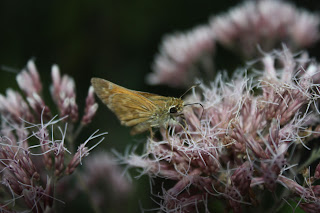Joe Pye Weed is Eupatorium purpureum or Eutrochium fistulosum or angustifolium
 Most botanists put Joe-Pye-Weeds in the genus Eutrochium but most of us know it as Eupatorium.I've never seen plants for sale locally, but the seeds are fairly easy to start.
Most botanists put Joe-Pye-Weeds in the genus Eutrochium but most of us know it as Eupatorium.I've never seen plants for sale locally, but the seeds are fairly easy to start.
Plant them for the pollinators and for the sheer joy of their tall stemmed-beauty.
Swallowtail Gardens sells both pink and white varieties - 50 seeds for $3.Kansas State Extension Service has a great online reference called "Farming a Few Acres of Herbs: An Herb Growers Handbook" at http://www.ksre.ksu.edu/ksherbs/farming_a_few_acres.htm.
On The Deep Middle blog they agree, even in August in a drought, Joe Pye continues to feed our eyes and the pollinators.
On Flora Pittsburghensis, Wild Flowers of Pittsburgh, Eupatorium fistulosum was featured Aug, 2011.
"This magnificent plant, with its domes of dusty-rose flowers on towering stems, is common in damp fields and roadsides everywhere; these plants grew in a moist depression in Schenley Park, side by side with their close cousins the Spotted Joe-Pye-Weeds (E. maculatum). Enlightened gardeners who have space for a few eight-foot towers in their perennial beds are beginning to discover and make use of this plant, which can now be seen in some of Pittsburgh’s most tasteful gardens.
The taxonomy of the Joe-Pye-Weeds seems to be in an awful mess. Alphonso Wood’s Class-Book of Botany seems to be closest to the modern botanists’ classification of this species, so we use Wood’s description here:
EUPATORIUM.
Dedicated to Eupator, king of Pontus, who first used the plant in medicine. (Mithridates VI Eupator (132-63): king of Pontus (120-63), enemy of Rome in first century BCE.)
Flowers all tubular; involucre imbricate, oblong; style much exserted (protruded stamens), deeply cleft; anthers included; receptacle naked, flat ; pappus simple, scabrous; achenia 5-angled.—Perennial herbs, with opposite or verticillate leaves. Heads corymbose. Flowers of the cyanic series, that is, white, blue, red, ., never yellow.
* Leaves verticillate (whorled). Flowers purple.
E. fistulosum Barratt. (E. purpureum Willd. in part. E. incarnatum Linn., in part. E. purpureum, v. angustifolium T. & G.) Trumpet-weed.—Stem fistulous, glabrous, glaucous-purple, striate or fluted; leaves in about 12 whorls of 6s, largest in the middle of the stem, rather finely glandular-serrate; midvein and veinlets livid purple; corymb globose, with whorled peduncles.—Thickets, U. S. and Can., very abundant in the Western States! Height 6-10 ft., hollow its whole length. Leaves, including the 1″ petiole, 8″ by 2″. Corymb often 1 ft. diam. Flowers purple. The glaucous hue and suffused redness of this majestic plant are most conspicuous in flowering-time. It does not appear to possess the acrid properties of E. maculatum.




Comments